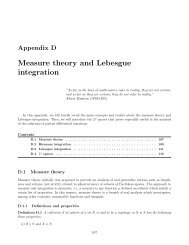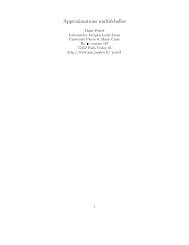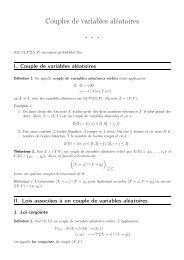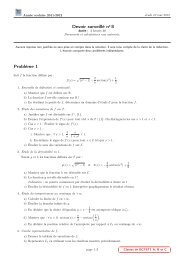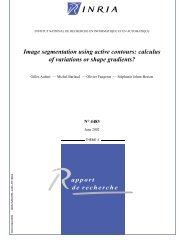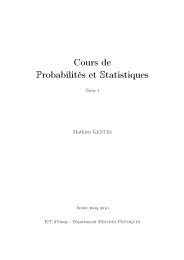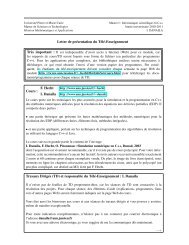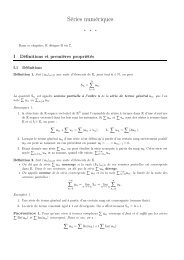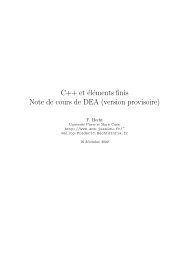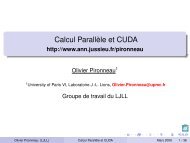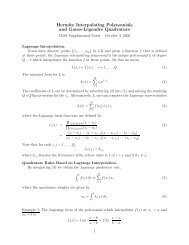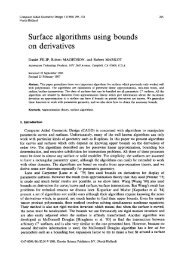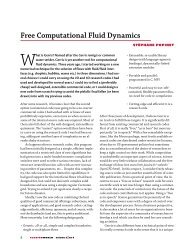192 C. Dobrzynski and P. Frey Fig. 4. Airflow simulation: adapted meshes at iterations 1, 99 and 500 (top); streamlines and velocity modulus (bottom) 6 Conclusions and Perspectives In this paper, we have presented an efficient method <strong>for</strong> obtaining anisotropic adapted meshes based on Riemannian metric specifications. This approach is based on amodification of the classical <strong>Delaunay</strong> kernel and involve local mesh modification operations. The results obtained so far in the numerical simulations are promising and confirm the cogency of the local modification strategy. The next stage will be to handle dynamically evolving domains where both the geometry and the topology of the domains change in time. References 1. Alauzet, F., Loseille, A., Dervieux, A., Frey, P.: Multi-dimensional continuous metric <strong>for</strong> mesh adaptation. In: Proc. 15th Int. <strong>Mesh</strong>ing Roundtable, pp. 191–214 (2006) 2. Apel, T., Berzins, M., Jimack, P.K., Kunert, G., Plaks, A., Tsukerman, I., Walkley, M.: <strong>Mesh</strong> shape and anisotropic elements: Theory and practice. In: Whiteman, J.R. (ed.) The Mathematics of Finite Elements and Applications X, pp. 367–376. Elsevier, Ox<strong>for</strong>d (2000)
<strong>Anisotropic</strong> <strong>Delaunay</strong> <strong>Mesh</strong> <strong>Adaptation</strong> <strong>for</strong> <strong>Unsteady</strong> <strong>Simulations</strong> 193 3. DAzevedo, E.F., Simpson, R.B.: On optimal triangular meshes <strong>for</strong> minimizing the gradient error. Numer. Math. 59, 321–348 (1991) 4. Babuška, I., Aziz, A.K.: On the angle condition in the finite element method. SIAM J. Numer. Anal. 13, 214–226 (1976) 5. Baker, T.J.: <strong>Mesh</strong> Movement and Metamorphosis. Eng. Comput. 18(3), 188–198 (2002) 6. Berzins, M.: A solution-based triangular and tetrahedral mesh quality indicator. SIAM J. Sci. Comput. 19, 2051–2060 (1998) 7. Bossen, F.J., Heckbert, P.S.: A pliant method <strong>for</strong> anisotropic mesh generation. In: Proc. 5th Int. <strong>Mesh</strong>ing Roundtable, pp. 63–74 (1996) 8. Borouchaki, H., Hecht, F., Frey, P.: <strong>Mesh</strong> gradation control. Int. J. Numer. Methods Engng. 43(6), 1143–1165 (1998) 9. Castro-Diaz, M.J., Hecht, F., Mohammadi, B., Pironneau, O.: <strong>Anisotropic</strong> unstructured mesh adaption <strong>for</strong> flow simulations. Int. J. Numer. Meth. Fluids 25, 475–491 (1997) 10. Ciarlet, P.G.: The Finite Element Method <strong>for</strong> Elliptic Problems. North-Holland, Amsterdam (1978) 11. Chernikov, A., Crisochoides, N.: Three-dimensional semi-generalized point placement method <strong>for</strong> <strong>Delaunay</strong> mesh refinement. In: Proc. 16th Int. <strong>Mesh</strong>ing Roundtable, Seattle, pp. 25–44 (2007) 12. Dolejsi, V.: <strong>Anisotropic</strong> mesh adaptation <strong>for</strong> finite volume and finite element methods on triangular meshes. Computing and Visualisation in Science 1, 165–178 (1998) 13. Dompierre, J., Vallet, M.-G., Bourgault, Y., Fortin, M., Habashi, W.G.: <strong>Anisotropic</strong> mesh adaptation: Towards user-indepedent, mesh-independent and solver-independent CFD. Part III: Unstructured meshes. Int. J. Numer. Meth. Fluids 39, 675–702 (2002) 14. Ducrot, V., Frey, P.: Contrôle de l’approximation géométrique d’une interface par une métrique anisotrope. C.R. Acad. Sci. 345, Série I, 537–542 (2007) 15. Formaggia, L., Perotto, S.: New anisotropic a priori error estimates. Numer. Math. 89, 641–667 (2001) 16. Fortin, M.: Etude numérique d’estimations d’erreur a posteriori. REEF 9, 467–486 (2000) 17. Frey, P.: About surface remeshing. In: Proc. 9th Int. <strong>Mesh</strong>ing Roundtable, pp. 123–136 (2000) 18. Frey, P.J., George, P.L.: <strong>Mesh</strong> generation. Application to finite elements, 2nd edn. Wiley, Chichester (2008) 19. Frey, P.J., Alauzet, F.: <strong>Anisotropic</strong> mesh adaptation <strong>for</strong> CFD simulations. Comput. Methods Appl. Mech. Engrg. 194(48-49), 5068–5082 (2005) 20. George, P.L.: Premières expériences de maillage automatique par une méthode de <strong>Delaunay</strong> anisotrope en trois dimensions, RT-0272, Inria (2002) 21. George, P.L., Borouchaki, H.: <strong>Delaunay</strong> triangulation and meshing. Applications to finite elements, Hermès Science, Paris (1998) 22. Gruau, C., Coupez, T.: 3d unstructured and anisotropic mesh generation with adaptation to natural and multidomain metric. Comput. Methods Appl. Mech. Engrg. 194(48-49), 4951–4976 (2005) 23. Huang, W.: Metric tensors <strong>for</strong> anisotropic mesh generation. J. Comput. Phys. 204, 633–665 (2005) 24. Jiao, X., Colombi, A., Ni, X., Hart, J.: <strong>Anisotropic</strong> mesh adaptation <strong>for</strong> evolving triangulated surfaces. In: Proc. 15th Int. <strong>Mesh</strong>ing Roundtable, pp. 173–190 (2006)



